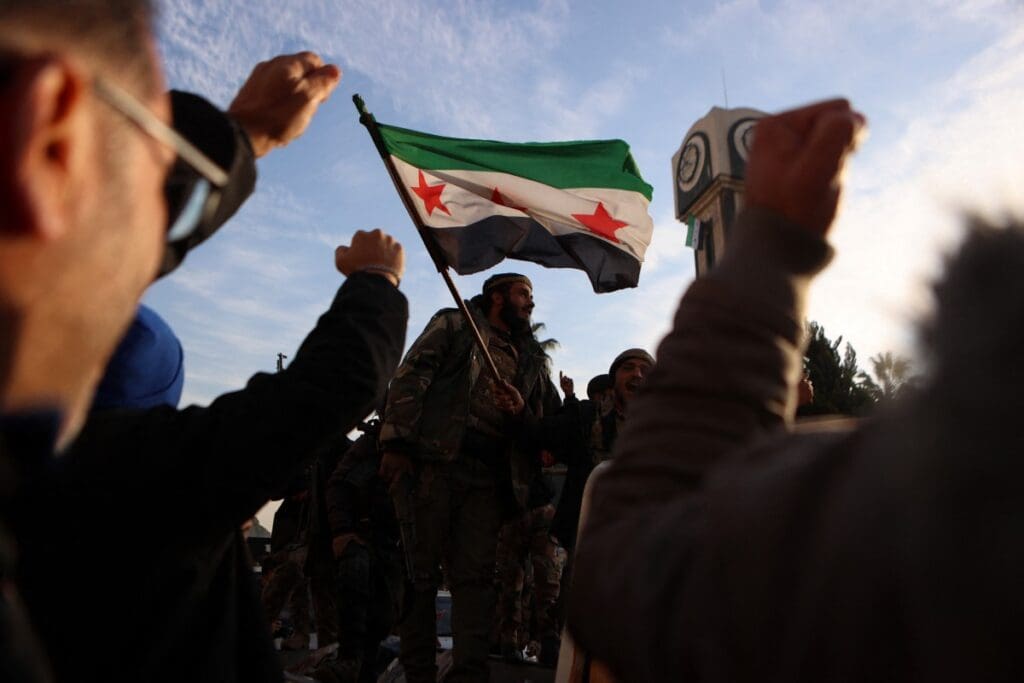On December 8, the world awoke to stunning news. Overnight, rebel forces led by Hayat Tahrir al-Sham (HTS) had taken Damascus, facing little resistance as they entered the Syrian capital. Most of the state’s security agents and armed forces simply abandoned their positions and walked away. In an instant, the Assad regime’s fifty-four-year brutal rule over the country had come to an end.
While the state’s sudden collapse was nothing short of breathtaking, the road to a stable and secure future will be anything but.
The Toppling
On November 27, HTS launched a large-scale operation in western Aleppo, in coordination with other rebel groups. Three days later, they had taken control of Syria’s second largest city and turned south. Town after town and city after city fell in their march towards Damascus, which they seized only eight days later.
Many people initially fled their homes because they feared the chaos that might ensue after rebel forces took over their towns, and dreaded the brutal tactics that the army would employ in its efforts to take back territory and cities it lost. The physical destruction and psychological scars of the barrel bombs the army deployed against rebel-occupied towns a few years earlier remain all too real.
In the end, neither fear materialized. As HTS and other rebel groups advanced, they encountered some pockets of resistance, but most soldiers simply ceded their positions and walked away rather fight. The consistency with how this scene played out across the country underscored the degree to which Syria’s institutions have become hollow and dysfunctional over the past decade.
Also impressive was the HTS fighters’ discipline and maturity in dealing with liberated areas. They maintained order and security and assuaged minority communities with messages of tolerance and peaceful coexistence. By the time HTS had reached Homs and Damascus, the cities’ citizens greeted them as liberators and celebrated their freedom.
The Hollow State
The rapid disintegration of the Syrian army was shocking, but not surprising. It was the result of a decade of state and economic disintegration. In 2017, after the regime, supported by Iran, Russia and Hezbollah, reestablished control over much of the country, it failed to introduce needed economic and political reforms. Instead, it cannibalized the private sector to benefit cronies and pay the salaries of the more than 1.5 million government employees. Private companies closed, jobs disappeared and revenues dried up.
The regime resorted to printing money. The Syrian pounds lost over 99 percent of its value between 2011 and 2024, dropping from 46 pounds to the U.S. dollar to around 15,000 pounds to the dollar. Even with adjustments, by 2024 the salaries of public officials averaged roughly $15-20 per month, barely enough to put bread on the table. The salaries of army conscripts were far less.
It is critical to emphasize the degree to which Syria’s institutions atrophied and weakened during this time. In the public sector, absenteeism was the norm. Most workers held second jobs or engaged in petty corruption to make ends meet. Public services, including education, health and electricity, barely functioned in the cities and were non-existent in many rural areas. State resources and assets were quietly pilfered, undermining the ability of state institutions to function. With the private sector constrained, unemployment was rampant, wages stagnant, and the poverty rate close to 70 percent.
This the difficult reality that confronts HTS, or any transitional government that attempts to manage the post-Assad transition. Add to this the crippling effects of international sanctions, the involvement of foreign actors—Turkey, Russia, Iran, the United States and Israel—the presence of armed militia of all stripes, the potential reformation of regime forces as armed gangs, the internal displacement of over 7 million people, the potential return of many of the over 5 million refugees and more.
Cautious Optimism
Despite the challenges ahead, there is much to celebrate and be grateful for. The people of Syria have been freed from the yoke of a brutal authoritarian regime, and a mental prison spanning half a century. The international community had been making overtures to normalize relations with Assad, suggesting that his reign would persist. After decades of tyranny, repression, and bloodshed, no one expected that the regime’s demise would happen so quickly and with such limited loss of life.
The transfer of power also occurred rapidly and with little contention. Other rebel groups have deferred to HTS, even withdrawing from key positions in the capital to avoid conflict. The transitional government led by Mohammed al-Bashir, the former head of the rebel administration in Idlib, has met with the previous government to facilitate the peaceful and orderly transfer of public functions. The transitional government was given a mandate until March 2025, providing space for discussions to form a more inclusive government in the months ahead. The international community signaled its willingness to accept the legitimacy of a government that emerged from such an inclusive process.
While these are all hopeful signs, it is important to realize the political road ahead is highly uncertain. While HTS has worked hard to outgrow its jihadist roots, it remains an Islamist movement and has its own ideas of what an inclusive government means. While it has demonstrated a commitment to good governance and to protecting minority rights, the international community should not expect it to oversee the establishment of a fully inclusive, secular state. The future of Syria hinges on finding an acceptable middle ground and focusing on the most critical objective: a stable and free Syria.
After half a century of tyrannical, repressive rule that has warped people’s minds and undermined their sense of self and community, and after a thirteen-year civil war that has taken the lives of half a million people, displaced half the population, shattered the livelihoods of millions of families, and introduced a generation that only knows conflict and hardship, Syrians deserve a break. Syrians also deserve a chance to rebuild their lives and livelihoods and regain their human dignity. More than anything they want and deserve an end to conflict. There is much to do and much to rebuild. We are where we are. It is a good, if imperfect, place to start. Let us find a way to move forward from here.


